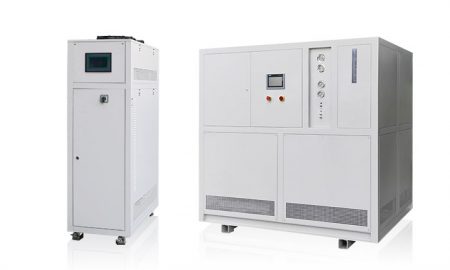How to Choose the Right Refrigeration Circulator for the Rotary Evaporator?
Choosing the right cooling method for evaporation experiments is beyond imagination for overall system performance, economy, and efficiency. As a necessary stage of the distillation process, the commonly used condensation methods at present mainly include: dry ice condenser, equipped or self-built cooling circulation system, and the method of using tap water for steam cooling. However, in most cases, it is necessary to purchase a refrigeration circulator as ancillary equipment.
When the refrigeration circulator is running, it cools the coolant filled in the water tank through its refrigeration system, and the built-in pump inputs the coolant to the condenser tube to absorb the heat of the steam in the condenser to achieve the effect of condensation. Finally, the cooling liquid with increased temperature is returned to the water tank for cooling, so that the cooling is circulated and exchanged to achieve a stable condensation temperature for the rotary evaporation system. At the same time, it can effectively avoid seasonal temperature changes that may occur in tap water. Moreover, choosing an efficient and environmentally friendly chiller instead of tap water cooling also helps to save water in the laboratory.
Important factors to consider when choosing the right refrigeration circulator include:
- Minimum condensing temperature and corresponding cooling capacity
- Cyclic pressure
- circulating flow
- suitable accessories
- Chiller Selection Guide
1. Minimum condensing temperature and corresponding cooling capacity
The minimum temperature of the cooling liquid needs to be lower than the temperature of the rotary evaporator to condense the solvent vapor at the optimum rate. This temperature is determined by the boiling point of the solvent. When selecting and setting the temperature of the equipment, it is generally recommended to follow the “20 rule”, that is, a temperature difference of 20°C is set between the heating pot temperature and the steam temperature, the steam temperature and the condenser temperature. For example, set the heating pan temperature to 60°C, adjust the vacuum setting of the system to generate solvent vapor at 40°C, and perform the condensing operation at 20°C. Therefore, the solvent vapor temperature is 20°C lower than the heating pot temperature, and the condenser temperature is 20°C lower than the steam temperature.
The lower the temperature that the refrigeration circulator can provide, the better the condensing effect. The refrigeration circulator usually has the maximum cooling capacity at 20°C or normal temperature, that is, the maximum cooling power parameter under ideal conditions, which is often the cooling power marked by the manufacturer.
As the temperature decreases, so does the cooling capacity that the refrigeration circulator can achieve. If the refrigeration circulator is at the set temperature, the cooling capacity is not enough to take away the heat of the cooling liquid in the distillation, which means that the cooling liquid will not reach the set temperature in the actual distillation, and the ideal condensation efficiency will not be achieved. Therefore, the cooling effect of the refrigeration circulator needs to comprehensively consider the two parameters of temperature and cooling capacity.
If the rotary evaporator needs to distill multiple solvents, then the cooling capacity of the equipment should be selected based on the minimum condensing temperature required. By looking at product specifications, you will find that refrigeration circulators have different cooling capacities at different temperatures. If the condenser is required to work at a relatively low temperature, it is necessary to have an in-depth understanding of the cooling capacity of the low temperature refrigeration cycle.
If the refrigeration circulator is underpowered at its set temperature, it means that in the actual distillation, the cooling liquid will not reach the set temperature and thus will not provide enough heat transfer effect to effectively condense the vapor. Vapors that cannot be cooled in time will be sucked into the vacuum pump, increasing the wear of the pump and shortening its service life, and may even cause irreparable damage. Also, if your refrigeration circulator has an over temperature alarm enabled, setting the temperature too low may cause the unit to alarm and shut down, and affect the performance of your distillation experiments.
2. Cyclic pressure
Another important factor to consider is the circulating pump pressure of the refrigeration circulator. Refrigeration circulators typically have pump pressures in the range of 10-15 psi (0.67-1.03 bar). If the pump pressure is too low, once there is a certain height difference between the rotary evaporator and the refrigeration equipment (for example, the equipment is placed under the test bench), the cooling liquid will not be able to circulate effectively in the condenser. If the pump pressure is too high, the risk of rupture inside the glass condenser due to excessive coolant pressure increases dramatically. The maximum pressure inside a common glass condenser is 1.5bar, so you need to pay attention to the applicable range of pressure.
When purchasing a refrigeration circulator, it is necessary to confirm the pressure range of the equipment and the working pressure range of the rotary evaporator condenser. In general, most refrigeration equipment compatible with rotary evaporation has a maximum pump pressure of 11.5 psi (≈0.8 bar), making it suitable for use with glass condensers. If the positive displacement pump and turbo pump are configured, they often have higher output pressure, so it is necessary to pay more attention to the pump pressure range, so as to avoid the increased risk of glass condenser rupture due to the use of the corresponding refrigeration circulator, or cooling due to insufficient pump pressure. Fluid cannot circulate efficiently.
3. Circulating flow
The pump flow of the refrigeration circulator affects the residence time of the coolant in the condenser. The lower the flow rate, the longer the coolant stays in the condenser. As the temperature increases, the heat transfer efficiency between the steam and the coolant decreases. In this case, there is an increased risk of insufficient condensation of solvent vapors.
Although the flow rate of most refrigeration circulators today is sufficient relative to their cooling power, it is still necessary to pay attention to this.
4. Accessories
Coolant and reinforced cooling water lines can select the appropriate coolant according to the temperature range.
If lower temperatures are required, an ethanol or glycol mixture is recommended. A common coolant is a mixture of ethylene glycol and water with inhibitors, ideal for most refrigeration circulators with rotary evaporators. CAUTION: Ethanol’s high flammability poses certain risks. Be very careful when using it as a coolant.
The cooling water line selected should match the chemical compatibility of the coolant used, the temperature range of the application, and the pressure rating. Improper selection of tubing will cause the tubing to burst immediately or with prolonged use. If operating at low temperatures, thermal jackets can be used to reduce heat loss due to ambient temperature effects.
5. Selection guide for refrigeration circulators
For different rotary evaporation applications, we provide a variety of refrigeration circulators to meet the individual needs of users.
Three basic points:
1. In order to protect the glass condenser, the maximum pump pressure of the cold refrigeration circulator must not exceed 2 bar.
2. In order to obtain the best distillation speed, it is recommended to follow the three-quarters principle: that is, at or below three-quarters of the height of the condenser, the steam should be effectively condensed to form droplets and be discharged as condensate, try to avoid steam When it reaches the upper quarter of the condenser, the steam is sucked by the vacuum pump because it cannot be cooled in time, thus affecting the performance of the pump.
3. The top of the glass condenser should always maintain an effective low temperature state to avoid steam being sucked into the vacuum pump.
LNEYA chiller manufacturers can provide chillers with various temperatures, cooling capacities and circulation pressures.
The temperature of the condenser is a key factor affecting the recovery rate, and LNEYA’s low temperature recirculating chillers are ideal for use with rotary evaporation applications. -40°C, -80°C, -120°C low temperature circulating liquid, supplemented by appropriate vacuum degree control, can effectively recover or evaporate organic solvents.
We are a professional manufacturer of temperature control equipment, supporting customized services, please consult us for details!
Temperature Control Range: -150°C to +50°C
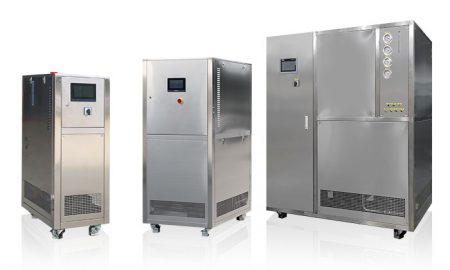
Dynamic Temperature Control Systems
Temperature Control Range: -120°C to +350°C
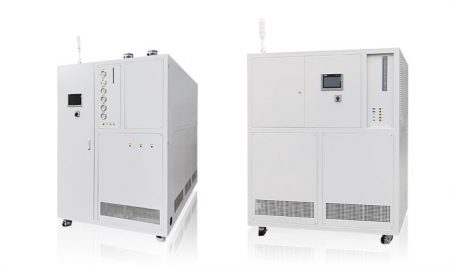
Temperature Control Range: -40°C to +100°C
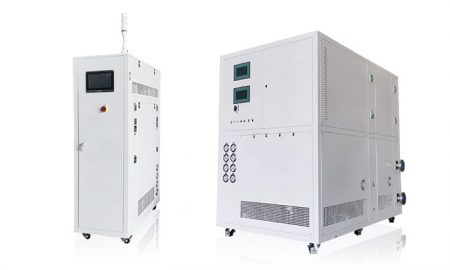
Temperature Control Range: -85°C to +250°C
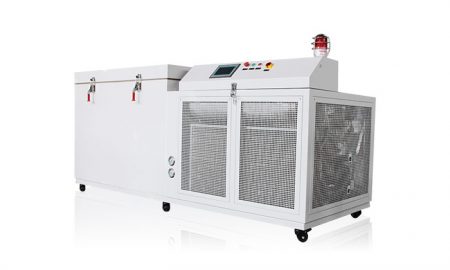
Temperature Control Range: -150°C to -10°C
 LNEYA
LNEYA
 简体中文
简体中文











































































